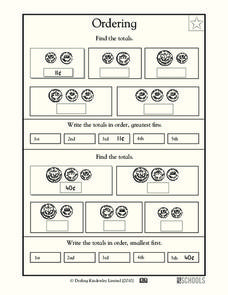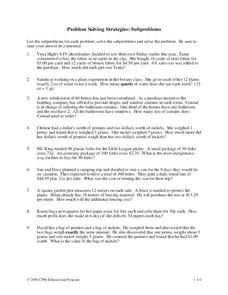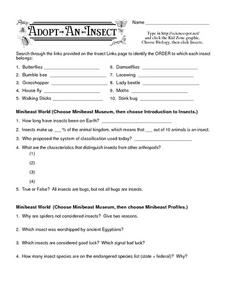Curated OER
Alphabetize For A Reason
Students organize information by using the alphabet. Students organize materials alphabetically. Students alphabetize with the first, second and third letters of a set of words. Students discover applications for alphabetical order.
Curated OER
Ordering
Money is a great medium for math problems, and learners practice with coins in these addition equations. First, they add up five sets of coins (one is done for them), writing down the totals below each. Next, scholars sequence these...
Curated OER
Build Mastery: Sequencing
Writing a summary is much easier once you've laid out the sequence of events. Show readers how these two skills are intertwined using this graphic organizer. Review the meaning of sequencing first, presenting the chart and possibly...
Curated OER
Comparing and Ordering
Before handing out this number comparison activity, ask scholars to pick a number between 20 and 50. Could they do it? Explain that they chose a number greater than 20 and less than 50, which is exactly what they will be doing next. Each...
Curated OER
In the Right Order
What comes first? Youngsters practice with sequence of events using a visual learning exercise, which has them examine three images to put things in order. For the first, they check off what comes before. For the next one, they...
Curated OER
Range, Mode, and Median
Fifth and sixth graders sort data from least to greatest and mark an X on the line plot to show how many of each number. Then they determine the range, mode, and median for the problem.
Curated OER
Paper Clip Game for Learning the Value of Rules
Students explore the components of good rules and their importance in society. Consistency and fair application for the maintenance of order is emphasized as paper clips and the rules of a game are manipulated.
Curated OER
The Number Line
Represent, order, and compare rational numbers in order to practice placing them on a number line. Your class will use appropriate operations, methods, and tools to compute with real numbers. Then they must explain completely and clearly...
Curated OER
Does Order Really Matter?
Investigate the order of operations! Learners participate in interactive multi-media activities to examine and solve multi-step equations, inequalities. They evaluate formulas and simplify monomials and polynomials.
Houghton Mifflin Harcourt
Fraction Strips
Identify, compare, and order fractions with a hands-on learning tool. Fraction strips are a great way to help young mathematicians understand and visualize fraction values. The worksheet can be made into an activity in which pupils cut...
Curated OER
Unit 5: Order Whole Numbers in the 100s and 1,000s
There are three quick number ordering activities here for your mathematicians. First, they analyze data on the number of three types of pies sold. Scholars choose from four ordered lists the one showing fewest to most sold. Then, they...
Curated OER
Ordering
Although there isn't much to this number ordering activity, it offers some solid practice in sequencing two and three-digit numbers. For each of the 20 sets of four numbers, learners re-write them in order from least to greatest. All...
Curated OER
Order Numbers On a Number Line
Fifth and sixth graders study the use of a number line to add integers and they observe a teacher demonstration of how to add integers on a number line. Afterward, they construct a number line and use the number line to solve addition...
Curated OER
Fraction and Decimal Ordering
Ordering numbers just got physical! Learners practice putting numbers in sequence, both in fraction and decimal form. To begin, they line up in birthday order and discuss the difference between ascending and descending. They are then...
Norm Mitchell
Quiz: Representing, Comparing, and Ordering Decimals
Here is a 42-question quiz dealing with decimals to the thousandths place. It is comprehensive in that it has test takers use inequality signs to compare pairs of decimal numbers, choose the least- or greatest-valued nubmer out of a set...
Curated OER
Confusing Fractions and Decimals
Eight number lines are given, and math scholars need to place the given decimal numbers on the fraction line as accurately as possible. Each number line shows a different span of numbers. Consider having learners go through it the first...
Curated OER
Story Sequence
In this story sequence worksheet, students read five line nursery rhymes and then number the events in sequential order. There are four nursery rhymes on this two-page worksheet. An answer key is included.
Curated OER
Pet by Pet by Pet
In this ordinal number worksheet, 3rd graders examine the order of animals shown in a row at the top of the page. They answer questions that describe the position of each pet using ordinal numbers in 7 examples including 1 writing problem.
Curated OER
Problem Solving Strategies
In this problem solving strategies worksheet, students solve and complete 9 different word problems that include money and measurement. First, they list the sub-problems for each problem, solve the sub-problems and solve the problem....
Curated OER
Insect Mania
In this biology worksheet, learners create a game about insects using the Jeopardy game format and include at least 5 different topics with 5 questions for each topic. They also create a poster on at least 4 different orders of insects.
Curated OER
Adopt-An-Insect III
In this biology worksheet, learners search through the links provided on insects to identify the order to which each insect belongs. Then they write the characteristics that distinguish insects from other arthropods. Students also select...
Curated OER
Size
In this size learning exercise, students put a list of sixteen words in connection with water, wind and accommodation in order of size, with the biggest or strongest at the top.
Curated OER
Alphabet Fun
In this alphabet activity, students are given a letter of the alphabet. They must write the letter that comes before and after the given letter. Finally, students answer questions about the alphabet. There are 35 questions on this...
Curated OER
Sequencing: Pictures Tell a Story
Students listen to a story and observe five illustrations of the main events drawn by the teacher. They arrange the illustrations in sequential order. Then, working in groups of five, they read stories and select five events, one for...

























